The Intercohort Dynamics of Support for Redistribution in 54 Countries, 1985–2017
Abstract
1. Introduction
2. Background
2.1. Support for Redistribution
2.2. Intercohort Analysis
2.3. Welfare Regimes and SFR
2.4. Educational Attainment
3. Data and Methods
3.1. Dependent Variable
3.2. Key Independent Variables
3.3. Methods
4. Results
4.1. Descriptive Country Trends
4.2. Welfare Regime Variation, by Cohort and Year
4.3. Education Cohort Trends
4.4. Comparison of Multilevel Models
5. Discussion
Author Contributions
Funding
Conflicts of Interest
References
- Svallfors, S. Worlds of welfare and attitudes to redistribution: A comparison of eight western nations. Eur. Sociol. Rev. 1997, 13, 283–304. [Google Scholar] [CrossRef]
- Linos, K.; Martin, W. Self-interest, social beliefs, and attitudes to redistribution. Re-addressing the issue of cross-national variation. Eur. Sociol. Rev. 2003, 19, 93–409. [Google Scholar] [CrossRef]
- Brooks, C.; Manza, J. Why Welfare States Persist: The Importance of Public Opinion in Democracies; University of Chicago Press: Chicago, IL, USA, 2008. [Google Scholar]
- Larsen, C.A. The institutional logic of welfare attitudes: How welfare regimes influence public support. Comp. Political Stud. 2008, 41, 45–168. [Google Scholar] [CrossRef]
- Breznau, N. The missing main effect of welfare state regimes: A replication of ‘Social policy responsiveness in developed democracies’ by Brooks and Manza. Sociol. Sci. 2015, 2, 420–441. [Google Scholar] [CrossRef]
- Kenworthy, L.; McCall, L. Inequality, public opinion and redistribution. Socio-Econ. Rev. 2007, 6, 35–68. [Google Scholar] [CrossRef]
- Steele, L.G. Income Inequality, Equal Opportunity, and Attitudes about Redistribution. Soc. Sci. Q. 2015, 96, 444–464. [Google Scholar] [CrossRef]
- Steele, L.G. Ethnic Diversity and Support for Redistributive Social Policies. Soc. Forces 2016, 94, 1439–1481. [Google Scholar] [CrossRef]
- Breznau, N.; Maureen, A.E. Immigrant Presence, Group Boundaries, and Support for the Welfare State in Western European Societies. Acta Soc. 2016, 59, 195–214. [Google Scholar] [CrossRef]
- Van Heuvelen, T. Unequal views of inequality: Cross-national support for redistribution 1985–2011. Soc. Sci. Res. 2017, 64, 43–66. [Google Scholar] [CrossRef] [PubMed]
- Lupu, N.; Pontusson, J. The structure of inequality and the politics of redistribution. Am. Political Sci. Rev. 2011, 105, 316–336. [Google Scholar] [CrossRef]
- Gilens, M. Affluence and Influence: Economic Inequality and Political Power in America; Princeton University Press: Princeton, NJ, USA, 2012. [Google Scholar]
- Manza, J.; Brooks, C. How sociology lost public opinion: A genealogy of a missing concept in the study of the political. Sociol. Theory 2012, 30, 89–113. [Google Scholar] [CrossRef]
- Mau, S. The Moral Economy of Welfare States: Britain and Germany Compared; Routledge: London, UK, 2004. [Google Scholar]
- Brooks, C.; Manza, J. A broken public? Americans’ responses to the Great Recession. Am. Sociol. Rev. 2013, 78, 727–748. [Google Scholar] [CrossRef]
- Owens, L.A.; Pedulla, D.S. Material welfare and changing political preferences: The case of support for redistributive social policies. Soc. Forces 2013, 92, 1087–1113. [Google Scholar] [CrossRef]
- Brady, D.; Finnigan, R. Does immigration undermine public support for social policy? Am. Sociol. Rev. 2014, 79, 17–42. [Google Scholar] [CrossRef]
- Kuziemko, I.; Norton, M.I.; Saez, E.; Stantcheva, S. How elastic are preferences for redistribution? Evidence from randomized survey experiments. Am. Econ. Rev. 2015, 105, 1478–1508. [Google Scholar] [CrossRef]
- Sands, M.L. Exposure to inequality affects support for redistribution. Proc. Natl. Acad. Sci. USA 2017, 114, 663–668. [Google Scholar] [CrossRef] [PubMed]
- McCall, L.; Burk, D.; Laperrière, M.; Richeson, J.A. Exposure to rising inequality shapes Americans’ opportunity beliefs and policy support. Proc. Natl. Acad. Sci. USA 2017, 114, 9593–9598. [Google Scholar] [CrossRef] [PubMed]
- Deaton, A. Panel Data from Time Series of Cross-Sections. J. Econom. 1985, 30, 109–126. [Google Scholar] [CrossRef]
- Verbeek, M. Pseudo Panel Data. In The Econometrics of Panel Data; Advanced Studies in Theoretical and Applied Econometrics; Mátyás, L., Sevestre, P., Eds.; Springer: Dordrecht, The Neitherlands, 1996; Volume 33, pp. 280–292. [Google Scholar]
- Pampel, F.C.; Hunter, L.M. Cohort change, diffusion, and support for environmental spending in the United States. Am. J. Sociol. 2012, 118, 420–448. [Google Scholar] [CrossRef] [PubMed]
- Biegert, T. Welfare benefits and unemployment in affluent democracies: The moderating role of the institutional insider/outsider divide. Am. Sociol. Rev. 2017, 82, 1037–1064. [Google Scholar] [CrossRef]
- Jæger, M.M. The effect of macroeconomic and social conditions on the demand for redistribution: A pseudo panel approach. J. Eur. Soc. Policy 2013, 23, 149–163. [Google Scholar] [CrossRef]
- Olivera, J. Preferences for redistribution in Europe. IZA J. Eur. Lab. Stud. 2015, 4, 14. [Google Scholar] [CrossRef]
- Esping-Andersen, G. The Three Worlds of Welfare Capitalism; John Wiley & Sons: Hoboken, NJ, USA, 1990. [Google Scholar]
- Arts, W.; Gelissen, J. Three worlds of welfare capitalism or more? A state-of-the-art report. J. Eur. Soc. Policy 2002, 12, 137–158. [Google Scholar] [CrossRef]
- Kalmijn, M.; Kraaykamp, G. Social stratification and attitudes: A comparative analysis of the effects of class and education in Europe. Br. J. Soc. 2007, 585, 47–576. [Google Scholar] [CrossRef] [PubMed]
- Bosancianu, C.M. A Growing Rift in Values? Income and Educational Inequality and Their Impact on Mass Attitude Polarization. Soc. Sci. Q. 2017, 981, 587–1602. [Google Scholar] [CrossRef]
- McCall, L. The Undeserving Rich: American Beliefs about Inequality, Opportunity, and Redistribution; Cambridge University Press: Cambridge, MA, USA, 2013. [Google Scholar]
- Atkinson, A.B. Inequality: What Can Be Done; Harvard University Press: Cambridge, MA, USA, 2015. [Google Scholar]
- Van Heuvelen, T. Recovering the Missing Middle: A Mesocomparative Analysis of Within-Group Inequality, 1970–2011. Am. J. Sociol. 2018, 123, 1064–1116. [Google Scholar] [CrossRef]
- Bradley, D.; Huber, E.; Moller, S.; Nielsen, F.; Stephens, J.D. Distribution and redistribution in postindustrial democracies. World Politics 2003, 55, 193–228. [Google Scholar] [CrossRef]
- Kenworthy, L. Egalitarian Capitalism: Jobs, Incomes, and Growth in Affluent Countries; Russell Sage Foundation: New York, NY, USA, 2004. [Google Scholar]
- Brady, D. Rich Democracies, Poor People: How Politics Explain Poverty; Oxford University Press: Oxford, UK, 2009. [Google Scholar]
- Garfinkel, I.; Rainwater, L.; Smeeding, T. Wealth and Welfare States: Is America a Laggard or Leader? Oxford University Press: Oxford, UK, 2010. [Google Scholar]
- Gornick, J.C.; Milanovic, B. Income Inequality in the United States in Cross-National Perspective: Redistribution Revisited; LIS Center Research Brief: New York, NY, USA, 2015; pp. 1–7. [Google Scholar]
- Korpi, W. Power resources approach vs. action and conflict: On causal and intentional explanations in the study of power. Sociol. Theory 1985, 3, 31–45. [Google Scholar] [CrossRef]
- Brady, D.; Leicht, K.T. Party to inequality: Right party power and income inequality in affluent Western democracies. Res. Soc. Stratif. Mobil. 2008, 26, 77–106. [Google Scholar] [CrossRef]
- Burstein, P. American Public Opinion, Advocacy, and Policy in Congress: What the Public Wants and What It Gets; Cambridge University Press: Cambridge, MA, USA, 2014. [Google Scholar]
- Van Heuvelen, T. The religious context of welfare attitudes. J. Sci. Study Relig. 2014, 53, 268–295. [Google Scholar] [CrossRef]
- Shu, X.; Meagher, K.D. Beyond the Stalled Gender Revolution: Historical and Cohort Dynamics in Gender Attitudes from 1977 to 2016. Soc. Forces 2017, 31, 243–1274. [Google Scholar] [CrossRef]
- Fiel, J.E.; Zhang, Y. Three Dimensions of Change in School Segregation: A Grade-Period-Cohort Analysis. Demography 2018, 55, 33–58. [Google Scholar] [CrossRef] [PubMed]
- Svallfors, S. (Ed.) Contested Welfare States: Welfare Attitudes in Europe and Beyond; Stanford University Press: Redwood, CA, USA, 2012. [Google Scholar]
- Sachweh, P.; Olafsdottir, S. The welfare state and equality? Stratification realities and aspirations in three welfare regimes. Eur. Sociol. Rev. 2010, 28, 149–168. [Google Scholar] [CrossRef]
- Kahl, S. The religious roots of modern poverty policy: Catholic, Lutheran, and Reformed Protestant traditions compared. Eur. J. Soc. 2005, 46, 91–126. [Google Scholar] [CrossRef]
- Van Kersbergen, K.; Manow, P. (Eds.) Religion, Class Coalitions, and Welfare States; Cambridge University Press: Cambridge, UK, 2009. [Google Scholar]
- Castles, F.G.; Leibfried, S.; Lewis, J.; Obinger, H.; Pierson, C. (Eds.) The Oxford Handbook of the Welfare State; OUP Oxford: Oxford, UK, 2012. [Google Scholar]
- Huber, E.; Bogliaccini, J. Latin America. In The Oxford Handbook of the Welfare State; Castles, F.G., Leibfried, S., Lewis, J., Obinger, H., Pierson, C., Eds.; OUP Oxford: Oxford, UK, 2012. [Google Scholar]
- Peng, I.; Wong, J. East Asia. In The Oxford Handbook of the Welfare State; Castles, F.G., Stephan, L., Jane, L., Herbert, O., Christopher, P., Eds.; OUP Oxford: Oxford, UK, 2012. [Google Scholar]
- Van Oorschot, W. Making the difference in social Europe: Deservingness perceptions among citizens of European welfare states. J. Eur. Soc. Policy 2006, 16, 23–42. [Google Scholar] [CrossRef]
- Thelen, K. Varieties of Liberalization and the New Politics of Social Solidarity; Cambridge University Press: Cambridge, UK, 2014. [Google Scholar]
- Busemeyer, M.R.; Achim, G.; Simon, W. Attitudes towards redistributive spending in an era of demographic ageing: The rival pressures from age and income in 14 OECCD countries. J. Eur. Soc. Policy 2009, 191, 95–212. [Google Scholar] [CrossRef]
- Hayes, T.J. Do Citizens Link Attitudes with Preferences? Economic Inequality and Government Spending in the “New Gilded Age”. Soc. Sci. Q. 2013, 954, 68–485. [Google Scholar] [CrossRef]
- Wodtke, G.T. Are smart people less racist? Verbal ability, anti-black prejudice, and the principle-policy paradox. Soc. Prob. 2016, 63, 21–45. [Google Scholar] [CrossRef] [PubMed]
- Federico, C.M. When Do Welfare Attitudes Become Racialized? The Paradoxical Effects of Education. Am. J. Political Sci. 2004, 483, 74–391. [Google Scholar] [CrossRef]
- Heerwig, J.A.; Brian, J.M. Education and Social Desirability Bias: The Case of a Black Presidential Candidate. Soc. Sci. Q. 2009, 906, 74–686. [Google Scholar] [CrossRef]
- Stubager, R. Education effects on authoritarian-liberatian values: A question of socialization. Br. J. Sociol. 2008, 59, 327–350. [Google Scholar] [CrossRef] [PubMed]
- Werfhorst, H.G.V.D.; Graaf, N.D.D. The sources of political orientations in post-industrial society: Social class and education revisited. Br. J. Sociol. 2004, 55, 211–235. [Google Scholar] [CrossRef] [PubMed]
- Nawrotzki, R.J.; Pampel, F.C. Cohort change and the diffusion of environmental concern: A cross-national analysis. Popul. Environ. 2013, 35, 11–25. [Google Scholar] [CrossRef] [PubMed]
- Aarøe, L.; Petersen, M.B. Crowding out culture: Scandinavians and Americans agree on social welfare in the face of deservingness cues. Int. J. Politics 2014, 76, 684–697. [Google Scholar] [CrossRef]
| 1 | Another benefit of regime-based analyses is that regimes provide time-invariant country groups. A shift to the study of intercohort SFR change introduces important challenges in country-level measurement. For example, consider a college-educated individual born in 1940 who offers their view on SFR in 1995. At what time point should the country-level variable be measured? Any of 1940 (year of birth), 1962 (approximate year of labor market entry), or 1995 (date of survey administration) seem reasonable decisions. Future work is needed to determine the optimal method of measurement. |
| 2 | Of course, educational attainment is not the only characteristic that might be of interest for an intercohort analysis. We focus on it primarily because it is a durable indicator of socioeconomic status and has been widely examined in previous SFR research. We hope that future research extends our focus to other important microlevel characteristics. |
| 3 | Education is a particularly useful indicator of social class for the current study. With some exception, educational attainment tends to be fairly stable across the adult life course, unlike income or employment. We can therefore examine cohort differences by educational attainment without concern that different individuals may be in different groups based on the year of survey administration. |
| 4 | Early and later cohorts include longer bands to account for small sample sizes. |
| 5 | We make survey- and country-specific adjustments to be approximate a uniform measurement of tertiary educational attainment. |
| 6 | We do not have strong theoretical expectations for how SFR should vary across these regions. We thus examine them inductively. |
| 7 | A benefit of welfare regimes is that they are time invariant. We can thus measure cohort change in a similar grouping across individuals born decades apart. Other country-level variables, such as GDP per capita, introduce difficulties in comparison. For example, Poland cohorts are difficult to classify, as younger cohorts were born into a high income country, and older cohorts were born into a lower-middle income country. |
| 8 | This measure is the country-specific standardized measure of income, with a mean of zero. Missing values are imputed at zero and a binary indicator indicates respondents with missing income values. |
| 9 | We use a linear probability modeling strategy in both cases to ease the complexity of estimating cross-classified regression models. |
| 10 | This decline is 9% the magnitude of the maximum between-country difference in mean-SFR, discussed below. |
| 11 | In these results, we restrict samples to countries with four or more observations to compare cohort and year changes. |
| 12 | It is important to note that Eastern Europe is a widely heterogeneous set of countries. Some of these results might be due to the combination of different trajectories into a single category. Future work that focuses specifically on the heterogeneity of East Europe is needed. |
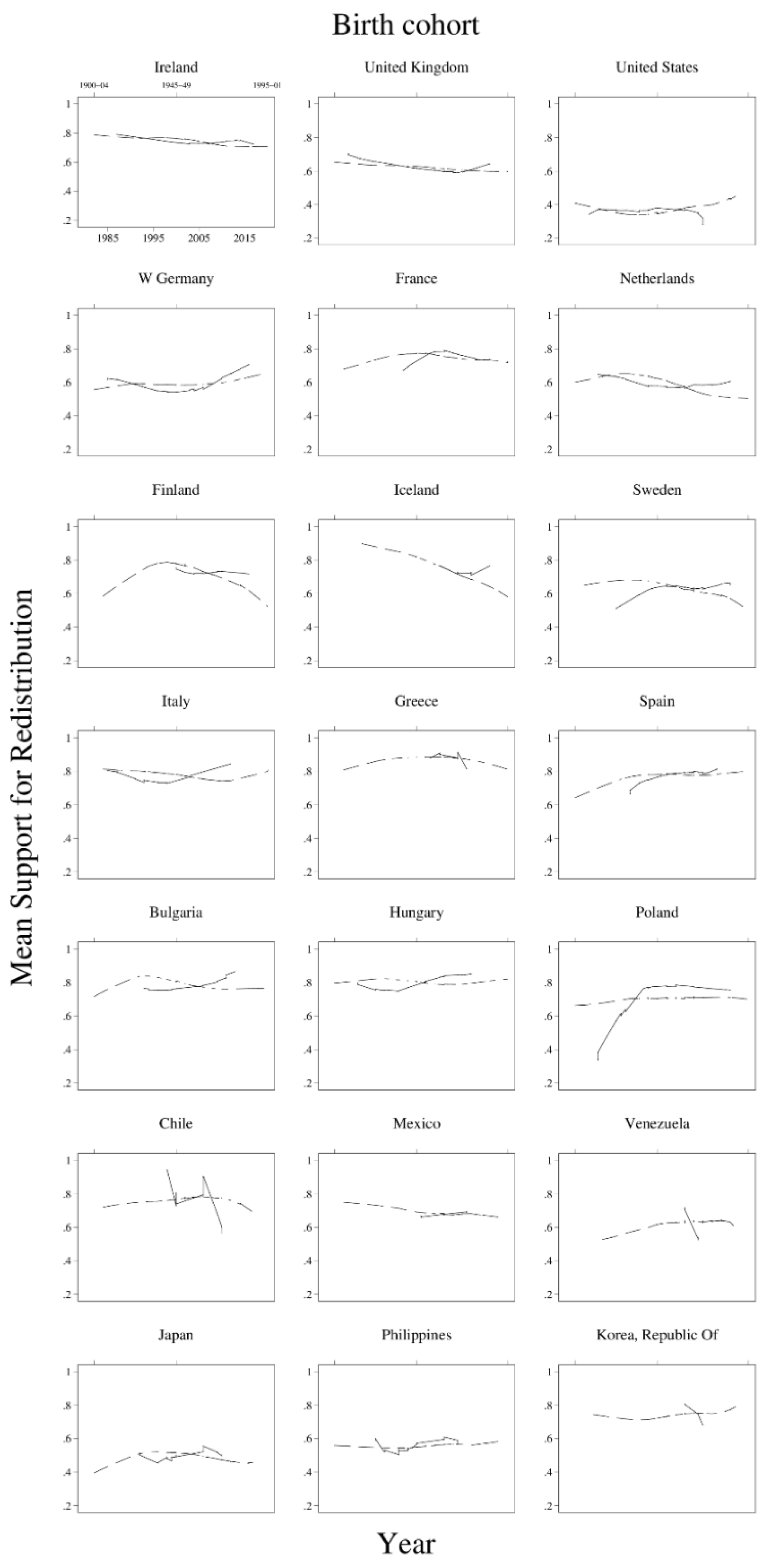
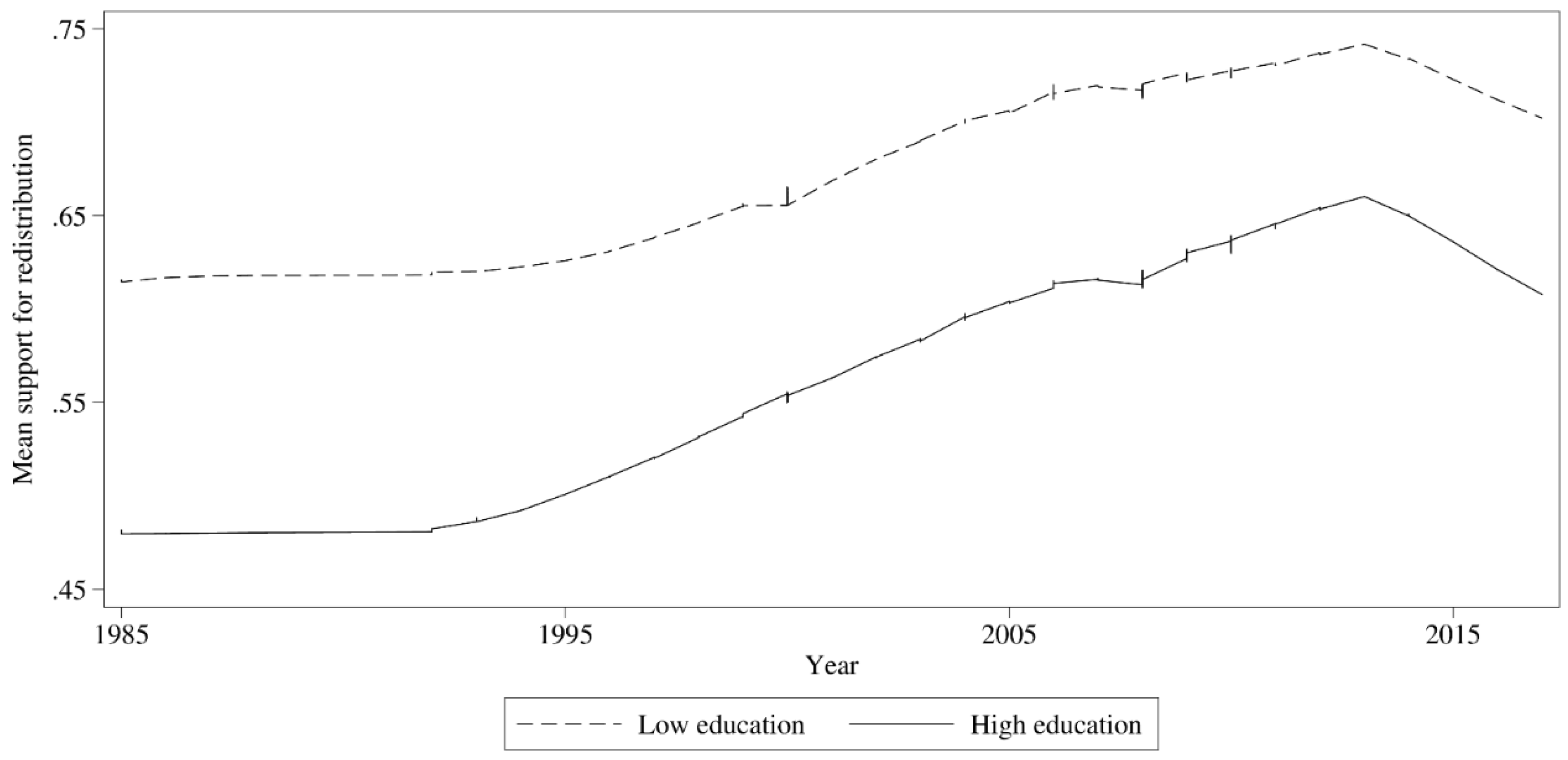
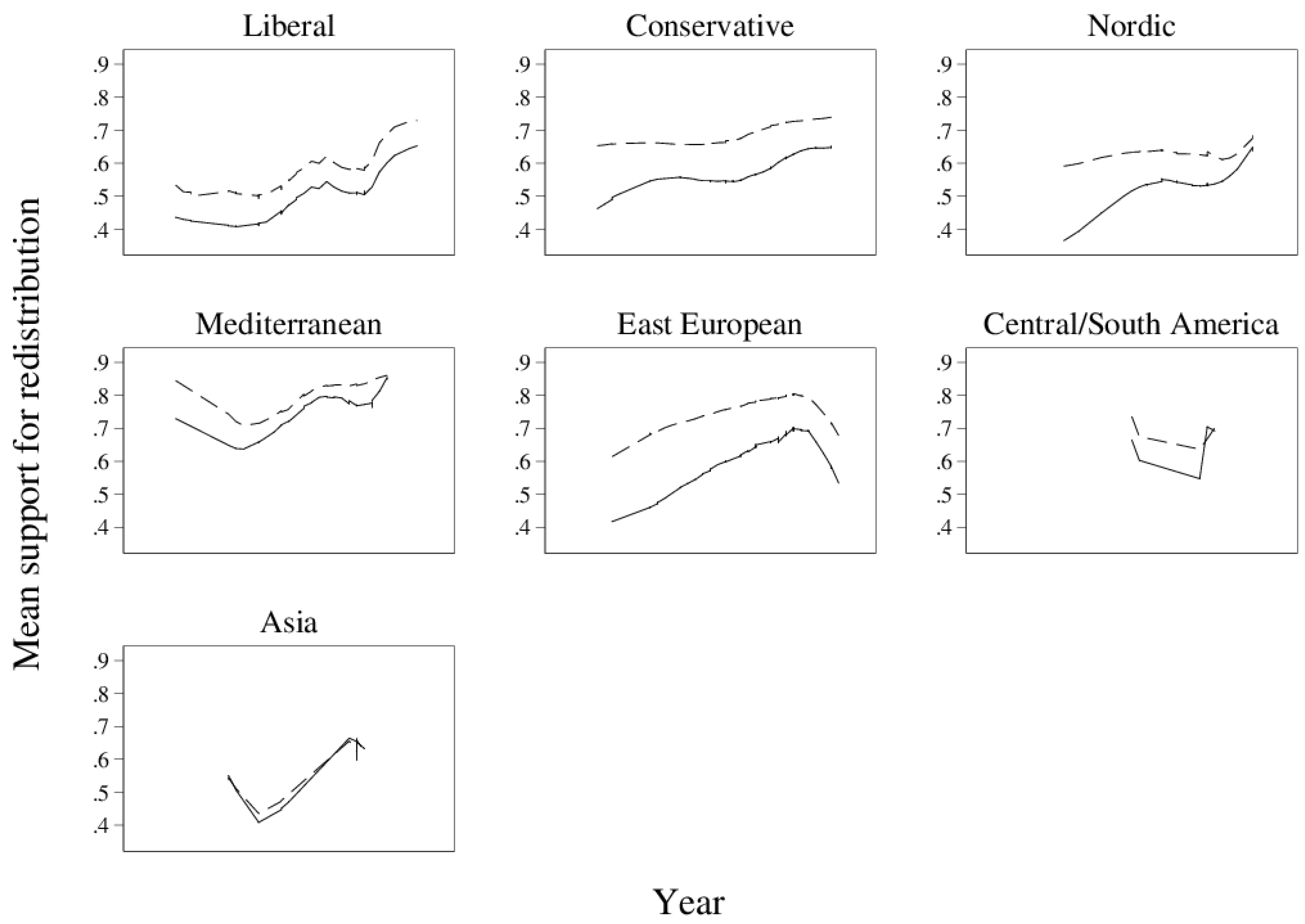
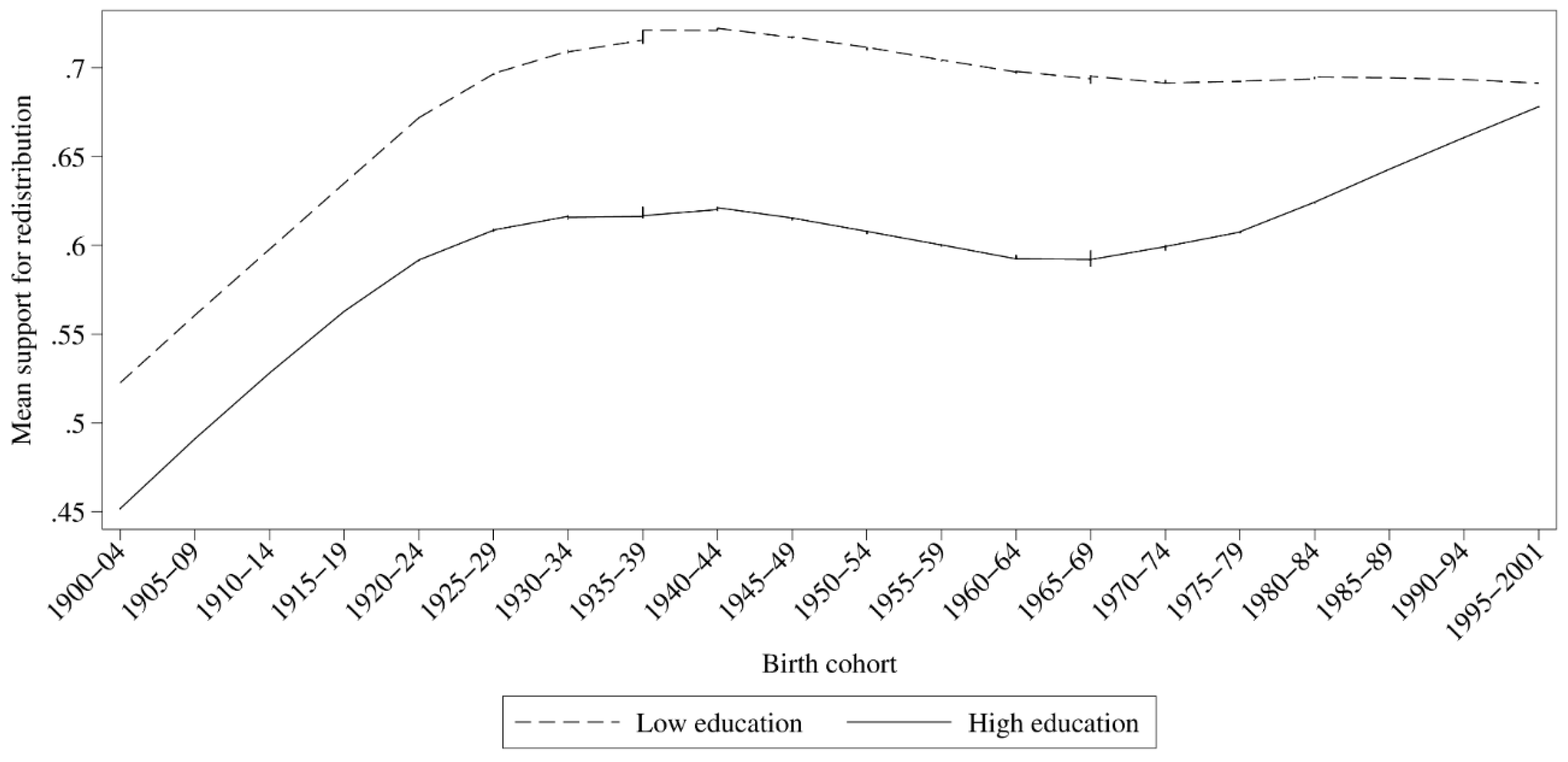
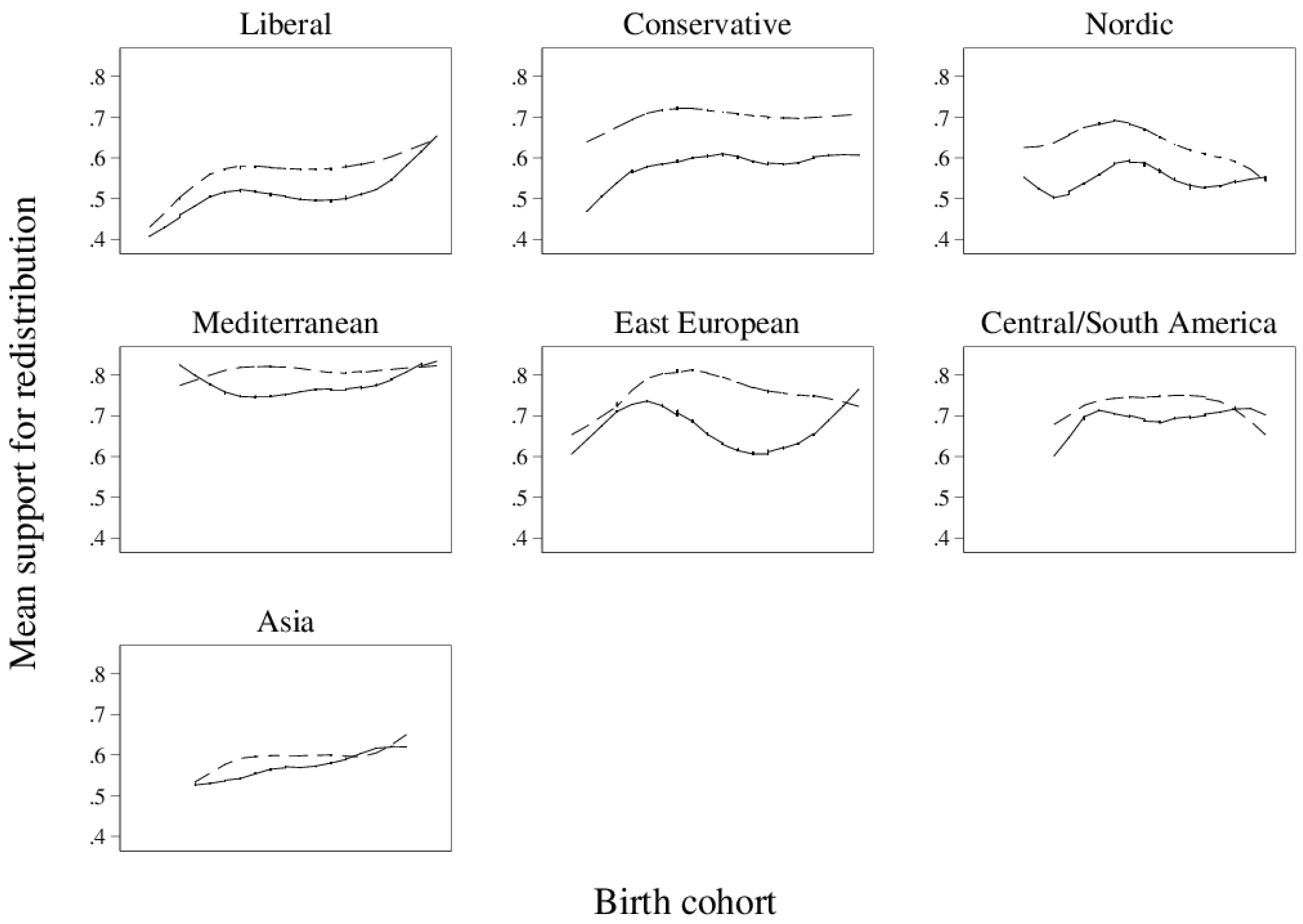
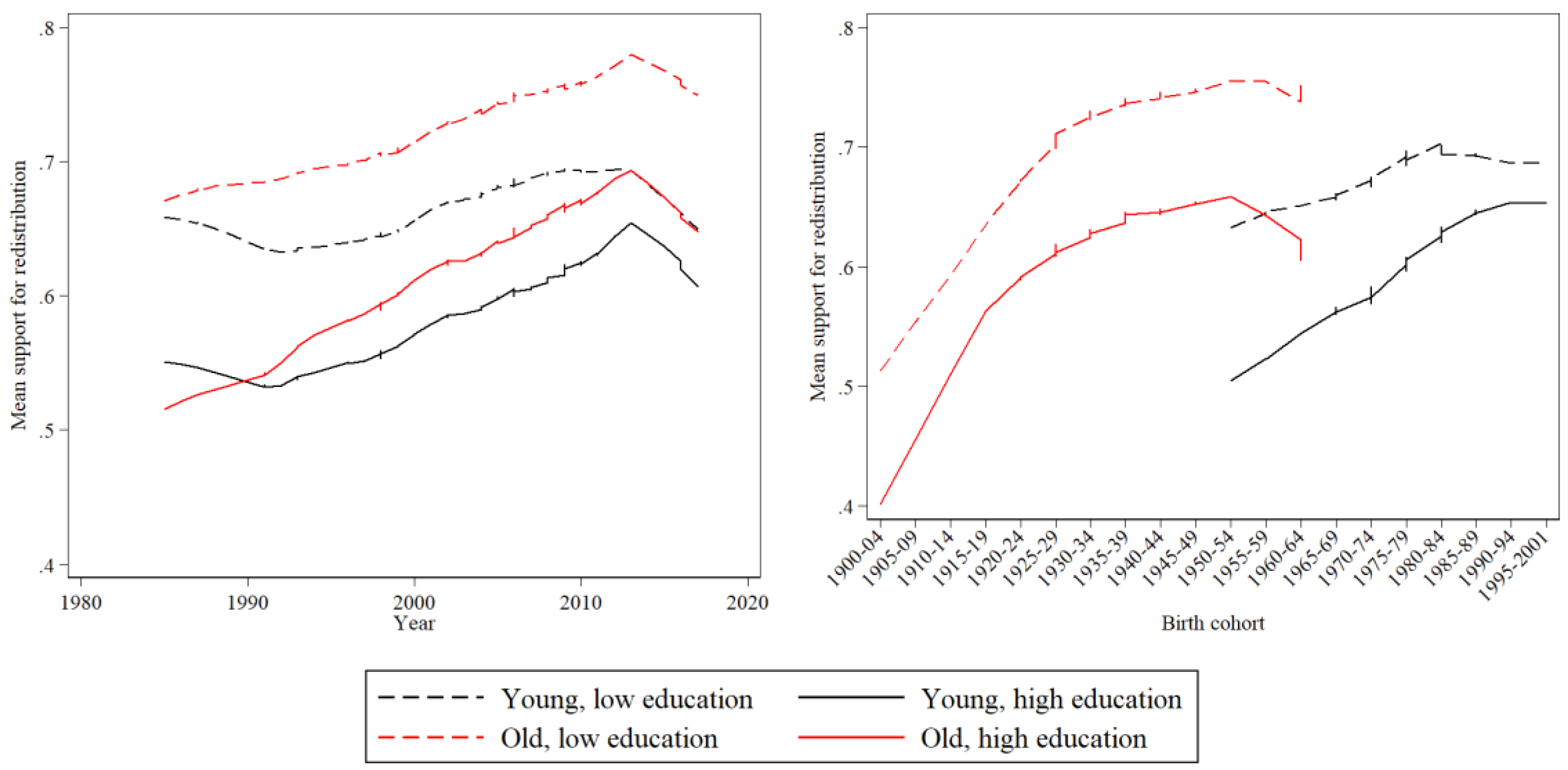
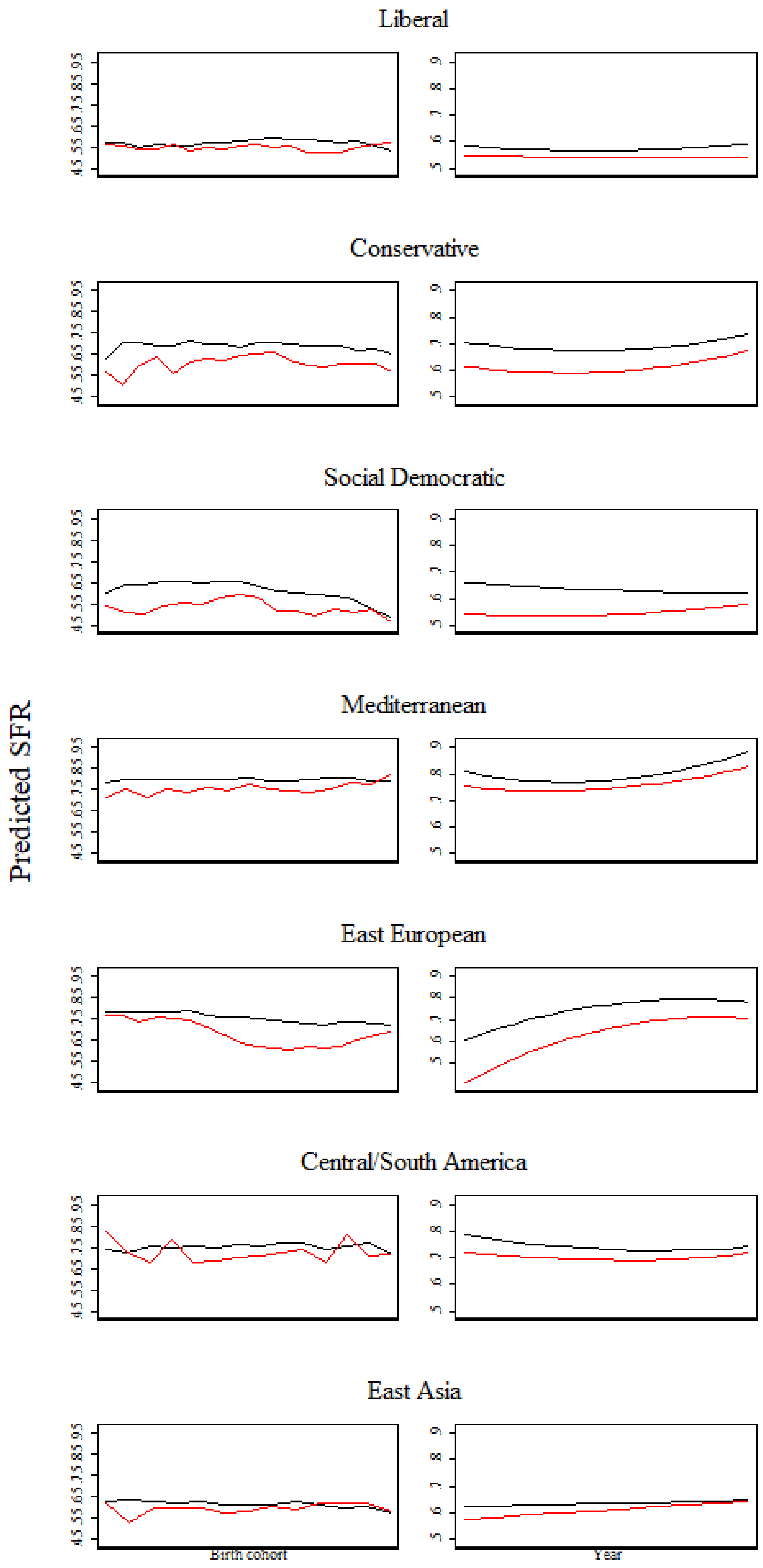
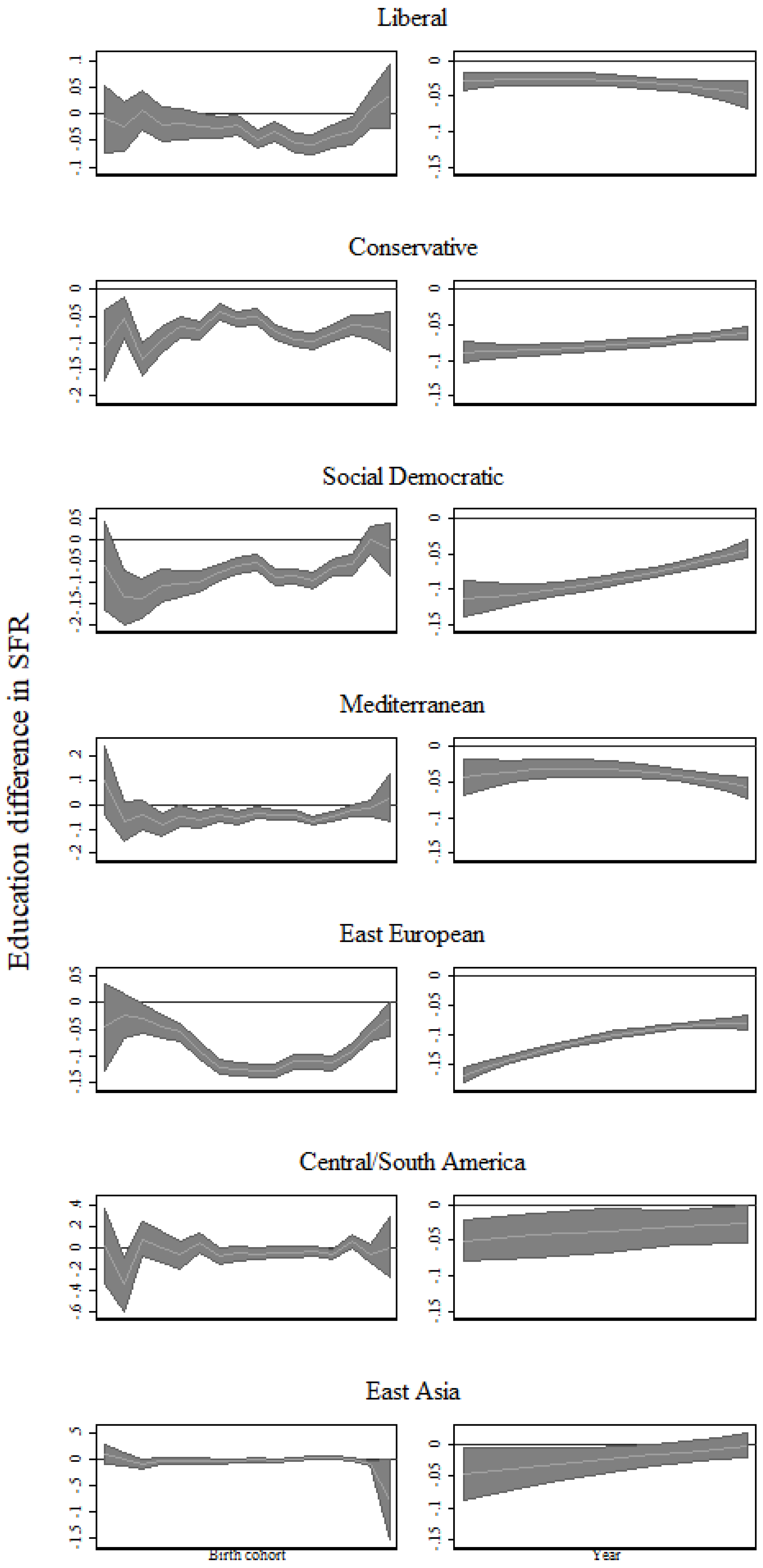
| Mean | SD | Min | Max | |
|---|---|---|---|---|
| Liberal regime 1 | ||||
| Support for redistribution (SFR) | 0.57 | 0 | 1 | |
| Year | 2000.31 | 8.78 | 1985 | 2017 |
| Birth year | 1952.86 | 18.78 | 1900 | 2001 |
| Has tertiary degree | 0.20 | 0 | 1 | |
| n = 114,189 | ||||
| Conservative regime | ||||
| SFR | 0.68 | 0 | 1 | |
| Year | 2004.46 | 8.08 | 1985 | 2016 |
| Birth year | 1957.29 | 18.96 | 1900 | 2001 |
| Has tertiary degree | 0.18 | 0 | 1 | |
| n = 186,622 | ||||
| Nordic regime | ||||
| SFR | 0.62 | 0 | 1 | |
| Year | 2005.99 | 6.69 | 1987 | 2016 |
| Birth year | 1959.06 | 18.49 | 1905 | 2001 |
| Has tertiary degree | 0.25 | 0 | 1 | |
| n = 92,595 | ||||
| Mediterranean regime | ||||
| SFR | 0.81 | 0 | 1 | |
| Year | 2003.87 | 6.96 | 1985 | 2013 |
| Birth year | 1956.80 | 18.86 | 1903 | 1998 |
| Has tertiary degree | 0.13 | 0 | 1 | |
| n = 74,607 | ||||
| East European regime | ||||
| SFR | 0.75 | 0 | 1 | |
| Year | 2005.00 | 7.62 | 1987 | 2017 |
| Birth year | 1958.54 | 18.84 | 1900 | 2001 |
| Has tertiary degree | 0.16 | 0 | 1 | |
| n = 200,083 | ||||
| Central/South America | ||||
| SFR | 0.74 | 0 | 1 | |
| Year | 2005.68 | 4.28 | 1998 | 2011 |
| Birth year | 1962.68 | 17.61 | 1906 | 1993 |
| Has tertiary degree | 0.09 | 0 | 1 | |
| n = 19,356 | ||||
| Asia | ||||
| SFR | 0.62 | 0 | 1 | |
| Year | 2003.31 | 6.39 | 1991 | 2010 |
| Birth year | 1959.52 | 17.17 | 1902 | 1994 |
| Has tertiary degree | 0.16 | 0 | 1 | |
| n = 36,246 |
| Regime | Mean | SD | Min | Max | Max-Min |
|---|---|---|---|---|---|
| Liberal | 0.573 | ||||
| Mean country SFR | 0.551 | 0.144 | 0.357 | 0.736 | 0.379 |
| Within country year SFR range | 0.239 | 0.029 | 0.196 | 0.271 | 0.075 |
| Within country birth cohort SFR range | 0.278 | 0.140 | 0.108 | 0.529 | 0.422 |
| Conservative | 0.672 | ||||
| Mean country SFR | 0.698 | 0.079 | 0.584 | 0.797 | 0.213 |
| Within country year SFR range | 0.235 | 0.141 | 0.070 | 0.517 | 0.447 |
| Within country birth cohort SFR range | 0.207 | 0.071 | 0.125 | 0.364 | 0.239 |
| Social Democratic | 0.619 | ||||
| Mean country SFR | 0.631 | 0.121 | 0.436 | 0.737 | 0.301 |
| Within country year SFR range | 0.159 | 0.082 | 0.057 | 0.268 | 0.211 |
| Within country birth cohort SFR range | 0.298 | 0.058 | 0.235 | 0.369 | 0.134 |
| Mediterranean | 0.811 | ||||
| Mean country SFR | 0.814 | 0.071 | 0.713 | 0.888 | 0.175 |
| Within country year SFR range | 0.190 | 0.111 | 0.098 | 0.361 | 0.263 |
| Within country birth cohort SFR range | 0.172 | 0.058 | 0.096 | 0.254 | 0.158 |
| East European | 0.746 | ||||
| Mean country SFR | 0.756 | 0.076 | 0.576 | 0.850 | 0.274 |
| Within country year SFR range | 0.218 | 0.130 | 0.046 | 0.544 | 0.498 |
| Within country birth cohort SFR range | 0.341 | 0.222 | 0.108 | 0.875 | 0.768 |
| Central/South America | 0.735 | ||||
| Mean country SFR | 0.716 | 0.072 | 0.633 | 0.787 | 0.154 |
| Within country year SFR range | 0.147 | 0.198 | 0.023 | 0.389 | 0.366 |
| Within country birth cohort SFR range | 0.280 | 0.140 | 0.263 | 0.300 | 0.037 |
| East Asia | 0.586 | ||||
| Mean country SFR | 0.627 | 0.128 | 0.501 | 0.744 | 0.243 |
| Within country year SFR range | 0.181 | 0.183 | 0.034 | 0.312 | 0.278 |
| Within country birth cohort SFR range | 0.430 | 0.200 | 0.326 | 0.530 | 0.204 |
| Range of regime-mean SFR | 0.238 | ||||
| Total sample: Mean country SFR | 0.691 | 0.127 | 0.357 | 0.888 | 0.530787 |
| Total sample: Within country year SFR range | 0.220 | 0.111 | 0.046 | 0.544 | 0.498074 |
| Total sample: Within country year SFR range | 0.265 | 0.151 | 0.096 | 0.875 | 0.779352 |
© 2018 by the authors. Licensee MDPI, Basel, Switzerland. This article is an open access article distributed under the terms and conditions of the Creative Commons Attribution (CC BY) license (http://creativecommons.org/licenses/by/4.0/).
Share and Cite
VanHeuvelen, T.; Copas, K. The Intercohort Dynamics of Support for Redistribution in 54 Countries, 1985–2017. Societies 2018, 8, 69. https://doi.org/10.3390/soc8030069
VanHeuvelen T, Copas K. The Intercohort Dynamics of Support for Redistribution in 54 Countries, 1985–2017. Societies. 2018; 8(3):69. https://doi.org/10.3390/soc8030069
Chicago/Turabian StyleVanHeuvelen, Tom, and Kathy Copas. 2018. "The Intercohort Dynamics of Support for Redistribution in 54 Countries, 1985–2017" Societies 8, no. 3: 69. https://doi.org/10.3390/soc8030069
APA StyleVanHeuvelen, T., & Copas, K. (2018). The Intercohort Dynamics of Support for Redistribution in 54 Countries, 1985–2017. Societies, 8(3), 69. https://doi.org/10.3390/soc8030069




